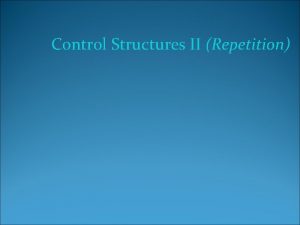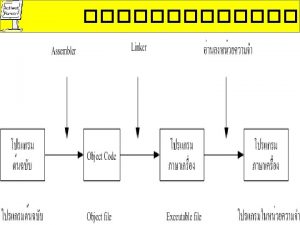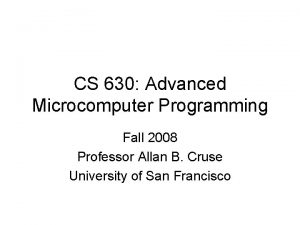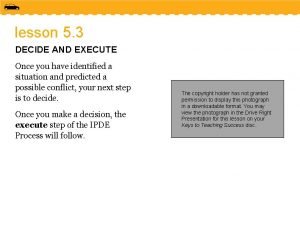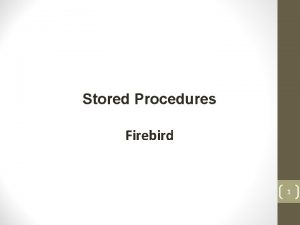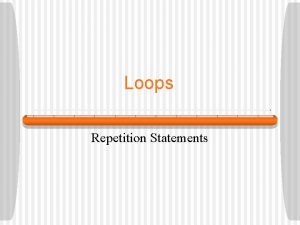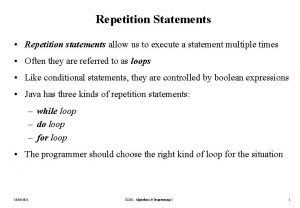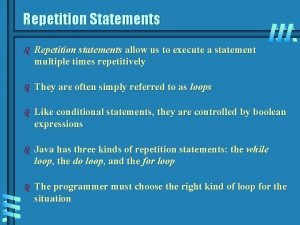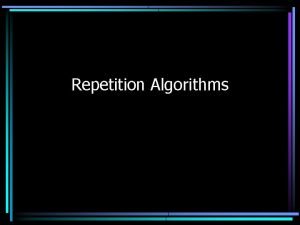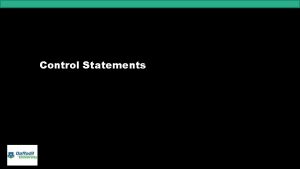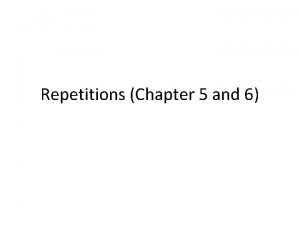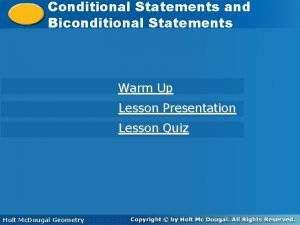Repetition Statements Repetition statements allow us to execute












- Slides: 12

Repetition Statements Ø Repetition statements allow us to execute a statement multiple times Ø Often they are referred to as loops Ø Like conditional statements, they are controlled by boolean expressions Ø The ap covers two kinds of repetition statements: • the while loop • the for loop Ø The programmer should choose the right kind of loop for the situation 1

The while Statement Ø The while statement has the following syntax: while is a reserved word while ( condition ) statement; If the condition is true, the statement is executed. Then the condition is evaluated again. The statement is executed repeatedly until the condition becomes false. 2

Logic of a while Loop condition evaluated true false statement 3

The while Statement Ø Note that if the condition of a while statement is false initially, the statement is never executed Ø Therefore, the body of a while loop will execute zero or more times 4

Infinite Loops Ø The body of a while loop eventually must make the condition false Ø If not, it is an infinite loop, which will execute until the user interrupts the program Ø This is a common logical error Ø You should always double check to ensure that your loops will terminate normally 5

Nested Loops Ø Similar to nested if statements, loops can be nested as well Ø That is, the body of a loop can contain another loop Ø Each time through the outer loop, the inner loop goes through its full set of iterations 6

The for Statement Ø The for statement has the following syntax: Reserved word The initialization is executed once before the loop begins The statement is executed until the condition becomes false for ( initialization ; condition ; increment ) statement; The increment portion is executed at the end of each iteration The condition-statement-increment cycle is executed repeatedly 7

The for Statement Ø A for loop is functionally equivalent to the following while loop structure: initialization; while ( condition ) { statement; increment; } 8

Logic of a for loop initialization condition evaluated true false statement increment 9

The for Statement Ø Like a while loop, the condition of a for statement is tested prior to executing the loop body Ø Therefore, the body of a for loop will execute zero or more times Ø It is well suited for executing a loop a specific number of times that can be determined in advance 10

The for Statement Ø Each expression in the header of a for loop is optional • If the initialization is left out, no initialization is performed • If the condition is left out, it is always considered to be true, and therefore creates an infinite loop • If the increment is left out, no increment operation is performed Ø Both semi-colons are always required in the for loop header 11

Choosing a Loop Structure Ø When you can’t determine how many times you want to execute the loop body, use a while statement Ø If you can determine how many times you want to execute the loop body, use a for statement 12
 A loop that continues to execute endlessly is called
A loop that continues to execute endlessly is called 4118 cont
4118 cont Fetch execute cycle steps
Fetch execute cycle steps Addw -8(%bp), %ax
Addw -8(%bp), %ax Java tvorca
Java tvorca Spare or execute alba
Spare or execute alba Fetch-decode-execute cycle
Fetch-decode-execute cycle Execute plan b
Execute plan b Lane positions
Lane positions Fetch decode execute cycle steps
Fetch decode execute cycle steps Brk segment overflow in thread #1: can't grow to
Brk segment overflow in thread #1: can't grow to Stored procedure firebird
Stored procedure firebird Fetch execute cycle
Fetch execute cycle
